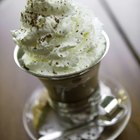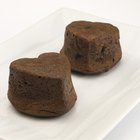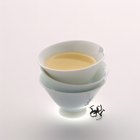
Much of a good restaurant's magic comes from preparing things that appear sophisticated and time-consuming, but are actually easy and simple to do. One example of that is panna cotta, a simple and clean-tasting Italian treat. It's usually made and served in individual portions, but it can also be made in a large dish as an attention-getting dessert for special occasions.
Panna Cotta Basics
Panna cotta's name literally means "cooked cream." In the days before refined gelatin became available, it was made by simmering cream with fish bones to extract their natural gelatin and set the cream. Modern versions use uncooked cream and milk in varying proportions, giving the finished dessert a fresher flavor. The most important detail with panna cotta is using enough gelatin to set the cream without becoming rubbery. Usually this takes approximately a tablespoon of unflavored gelatin powder for every 1 1/2 cups of cream or milk, with creamier versions requiring slightly less and milkier versions requiring slightly more.
The Basic Technique
Preparing a panna cotta is quick and simple by any standard. Sprinkle the powdered gelatin over the milk and wait a few minutes as it "blooms," or absorbs moisture and swells. Heat the milk gently until the gelatin dissolves, stir in the sugar, cream and flavorings, and you're done. Some flavorings, such as vanilla beans, take longer because they must be infused in hot milk to release their full flavor, but even that only requires 20 minutes or so. Once it's mixed, the panna cotta must be poured into its mold and refrigerated until it sets.
Large Versus Small Dishes
Most novices prefer to use small dessert cups or individual ramekins for their panna cotta at first, because small portions are easier to unmold. You can even keep your mixture warm, to slow the gelatin, and quickly set one portion in a chilled ramekin to make sure you've achieved the right texture. If not, you can add more cream or gelatin as needed. Once you're confident in your technique, you can graduate to preparing a single large dish. You can serve the panna cotta family style if the dish is attractive, or unmold it onto a serving plate.
Serving Suggestions
If you're unmolding your panna cotta, practice a few times before making one for company. They don't always unmold cleanly, so it helps to have some experience. Resting the dish briefly in a pan of hot water loosens the panna cotta and helps it unmold cleanly. For a more impressive appearance, use a jelly mold or decorative silicon baking pan to mold your panna cotta. Decorate it with fresh fruit, herbs, candied lemon zest or colorful sauces for the maximum impact. If you opt to leave your panna cotta in the dish and serve it family style, decorate the surface with similar garnishes.
Related Articles

How Long in Advance Can You Cook Creme ...

Adding Vanilla Pudding to Whipping Cream

How to Harden Up Whipped Cream

What Is a Souffle Dish?
What Do Bakeries Use in Their Whipped ...

How to Make Gelatin Dessert With Milk
The Difference Between ...

List of French Pastries

Can You Make Homemade Whipped Cream ...
A Substitute for Meringue

Tapioca Flour Vs. Quick Cooking Tapioca

How to Use Gelatin to Thicken Frosting

What Does Stabilizing Frosting Mean?
Easy Vanilla Cupcake Recipe
Baking Quiche the Day Before the Party

Do I Cook Frozen Broccoli Before Baking ...

How Long to Cool a Quiche

Substitute for Vanilla Custard Powder

Can You Use Milk Instead of Cream for ...

What Is the Difference Between Creme ...
References
- The Professional Pastry Chef; Bo Friberg
- The Kitchn: Why Panna Cotta Is the Perfect Dessert
Writer Bio
Fred Decker is a trained chef and prolific freelance writer. In previous careers, he sold insurance and mutual funds, and was a longtime retailer. He was educated at Memorial University of Newfoundland and the Northern Alberta Institute of Technology. His articles have appeared on numerous home and garden sites including GoneOutdoors, TheNest and eHow.
Photo Credits
Jupiterimages/Comstock/Getty Images